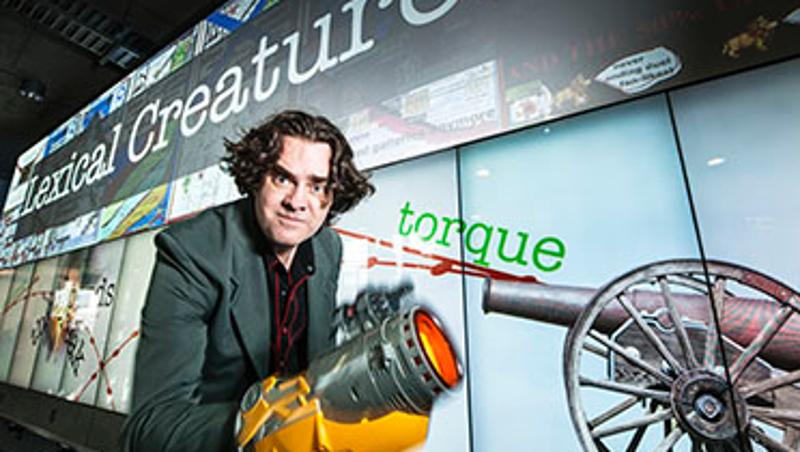
Ever wished you could take a shot at rewriting the news headlines?
QUT's newest digital writer in residence is building a poetry canon that can.
In an 'explosive' new display for the world's largest interactive display space, The Cube, Jason Nelson is spending six months gamifying poetry and art.
His primary project, Canonical, will see players load a virtual canon with words and fire them into a real-time feed of science headlines, transforming them into poetic phrases and artistic creatures.
"Poetry, to some extent, has become inaccessible to most people," said Dr Nelson, who is also a digital arts academic with Griffith University's Queensland College of Art.
"But people intuitively understand interactive interfaces like video games and they jump right in and play.
"Playing Canonical entices you to think about the language and how your actions within the game changes the language - through your play you become an active part of the writing and artistic process."
More poet than technologist, Dr Nelson has made an art form out of reimagining existing technology and game engines for artistic purposes.
The digital creator's residency at The Cube is supported by the Australia Council for the Arts in partnership with QUT.
It will draw largely on retro Atari games like Breakout and Space Invaders, replacing bullets and blocks with poetry and hand-drawn elements.
"I'm really excited to be working with The Cube's technology and transforming video games into artistic and poetic wonders! It's an amazing platform for imaginative play," Dr Nelson said.
"It's a fascinating process for me as an artist because it's such a unique space and I have to think carefully about designing projects for its specific geography of touchscreens and projectors."
Lexical Creatures is one of four Cube residencies. All focus on artistic endeavour that is inspired by science, technology, engineering and maths (STEM).
Cube Senior Curator, Lubi Thomas said bringing artists into contact with technologists and scientists allowed them all to benefit from both creative and methodical approaches to problem-solving, driving discovery and innovation.
"The Cube was created in part to build new pathways to thinking and creating innovation, and that's why we're injecting the arts into STEM to make STEAM," she said.
"The practice of digital creatives and artists often sits on the outer edges of the traditional art landscape and so they struggle to find display environments capable of presenting their work.
"The Cube offers the advanced software and hardware they need to thoroughly explore the interaction of art, technology and society."
The Cube's unique technical capabilities attract high-calibre artists from Australia and across the globe.
Dr Nelson and The Cube's previous digital writer in residence Christy Dena have both been nominated for the 2014 West Australian Premier's Book Awards, the only book awards of its type in Australia that offers a digital category.
QUT is hosting two European Media Artists in Residence Exchange (EMARE) residencies.
The Buildasound project, created by Spain's Spanish interactive artist Mónica Rikić, involves physical building blocks that allow the users to construct code to create their own musical event through creative play.
Swiss and German collaborative team of Mathias Jud & Christoph Wachter will focus on the plight and living conditions of refugees and asylum seekers attempting to come to Australia via boat.
Visit The Cube website for more information on its residencies and to read the artists' blogs.
RELATED STORIES
Meet the next generation of entertainment
Forget Sochi - it's gold, gold, gold to The Cube!
Digital writing residency explores robot ethics
The eco-race to beat congestion
Media contact:
Kate Haggman, QUT Media, kate.haggman@qut.edu.au, 3138 0358.
After hours Rose Trapnell, QUT Media team leader, 0407 585 901.




